You'll achieve pro-level fragrance testing by mastering temperature control, as even a 5°C shift can alter scent profiles by 30%. Start with room temperature baseline testing at 20-22°C (68-72°F), then evaluate your fragrances across seasonal ranges. Test florals at 18-22°C, citrus at 20-25°C, and woody scents at 22-27°C. Keep testing areas away from windows and vents for consistent results. These temperature fundamentals open the door to expert-level fragrance evaluation techniques.
Understanding Temperature's Impact on Fragrance Notes
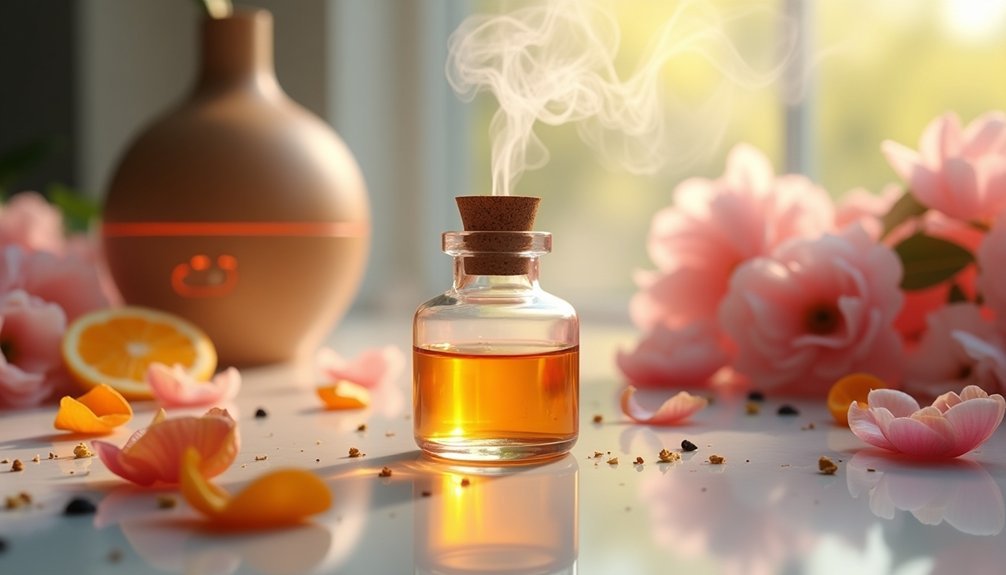
When you're testing fragrances, temperature plays a pivotal role in how their distinct notes reveal themselves. You'll notice that warm conditions make top notes more prominent while potentially subduing base notes, as heat increases their volatility.
The scent profile can change dramatically – warm temperatures might amplify amber and vanilla notes, while cool conditions often enhance floral and citrus fragrances.
To get the most accurate assessment, you should test your fragrances at room temperature first, as this provides a reliable baseline for stability.
You'll want to take into account how temperature fluctuations affect shelf life too, since heat can speed up chemical reactions and alter the fragrance's composition.
Cool environments typically help preserve the fragrance's integrity, ensuring it maintains its intended character longer.
Room Temperature Testing Protocols
You'll need to test your fragrances at room temperature for a minimum of three months to establish reliable stability benchmarks.
Keep your testing environment at a steady 20-22°C while monitoring both control and test samples for any variations in scent strength, profile changes, or physical alterations.
Your benchmark samples must remain in a controlled setting away from light exposure, humidity fluctuations, and temperature variations to guarantee accurate comparative results.
Optimal Testing Time Windows
To guarantee accurate fragrance evaluations, room temperature testing requires specific time windows and consistent monitoring protocols. You'll find that your Eau de perfumes need a full three-month testing period to reveal their true character. Follow these tips to help maintain consistent results: monitor light exposure, control temperature stability, and trust your sense of smell throughout the process.
| Time Window | Testing Focus | Environmental Factors |
|---|---|---|
| Week 1 | Initial profile | Room temp baseline |
| Week 4 | Stability check | Light exposure |
| Week 8 | Scent evolution | Humidity levels |
| Week 10 | Color changes | Air quality |
| Week 12 | Final assessment | Overall stability |
Record your observations systematically during these intervals, paying special attention to how environmental conditions affect the fragrance's performance. This methodical approach guarantees you'll capture all vital changes in your perfume's development.
Control Environmental Variables
Since accurate fragrance testing hinges on environmental stability, maintaining precise room temperature conditions is essential for reliable results. When testing your de Parfum or eau de toilette, you'll need to make certain the environment stays at 20-22°C (68-72°F) throughout the process.
- Set up your testing area away from windows and vents to avoid temperature fluctuations that could compromise your fragrance evaluation.
- Use calibrated thermometers to monitor room conditions consistently.
- Document the exact temperature readings during your testing sessions.
Keep your testing space free from direct sunlight, which can interfere with both temperature stability and fragrance performance.
Benchmark Sample Storage
Building on proper environmental controls, proper sample storage forms the backbone of accurate fragrance testing protocols. You'll need to store your test samples at 20-25°C (68-77°F), while keeping a reference sample in the fridge for comparison.
| Storage Condition | Testing Protocol |
|---|---|
| Room Temperature | Away from sunlight |
| Control Sample | Refrigerated |
| Dark Storage | Room temperature |
| Light Exposure | Controlled setting |
Monitor your samples over three months, comparing them against your refrigerated reference to detect any changes in scent intensity or appearance. You'll want to maintain detailed records of your observations throughout the testing period. Consider adding extra samples stored in different conditions to evaluate light exposure's impact on fragrance stability. This thorough approach guarantees you'll gather reliable data on your fragrance's performance and longevity.
Heat Exposure Effects on Scent Development
When you expose your fragrances to heat, you're actually witnessing an accelerated version of their natural aging process, where one year of changes can occur in just weeks at 40°C.
Your fragrance's chemical bonds start breaking down faster at elevated temperatures, causing volatile components to escape and aldehydes to transform into different compounds.
The resulting changes affect both the immediate scent profile and long-term stability of your perfume, making heat exposure a critical factor in understanding how your fragrance will perform over time.
Accelerated Aging Patterns
Understanding how heat affects fragrance development can help you predict a scent's long-term stability and performance. When you expose fragrances to elevated temperatures, you'll witness accelerated aging that mirrors natural degradation patterns. A three-month test at 40°C can reveal how your fragrance will perform after a full year at room temperature.
- Monitor your fragrance's appearance, color changes, and scent intensity closely during heat exposure tests to gauge long-term stability.
- Watch for unexpected chemical reactions, like acetal formation, which can occur when aldehydes and alcohols interact under heat stress.
- Keep your testing conditions consistent, as temperature fluctuations can mislead you about how specific scent notes will develop over time.
Remember that both light and heat exposure will speed up molecular breakdown, potentially altering your fragrance's intended character and strength.
Chemical Bond Breakdown
Three distinct chemical processes occur when heat disrupts fragrance bonds. You'll notice accelerated oxidation first, which transforms your fragrance's molecular structure and alters its intended scent profile. Next, heat triggers acetal formation when aldehydes interact with alcohols, fundamentally changing your perfume's character. Finally, you'll experience rapid evaporation of volatile compounds, leading to an unbalanced scent.
| Heat Effect | Primary Impact | Secondary Impact |
|---|---|---|
| Oxidation | Molecular Change | Scent Alteration |
| Acetal Formation | Compound Interaction | Profile Shift |
| Volatilization | Note Loss | Balance Disruption |
When testing fragrances, you'll want to monitor these chemical reactions closely. Watch for color changes, as they're reliable indicators of heat-induced degradation. Understanding these processes helps you predict how your fragrance will perform under various temperature conditions.
Cold Environment Testing Techniques
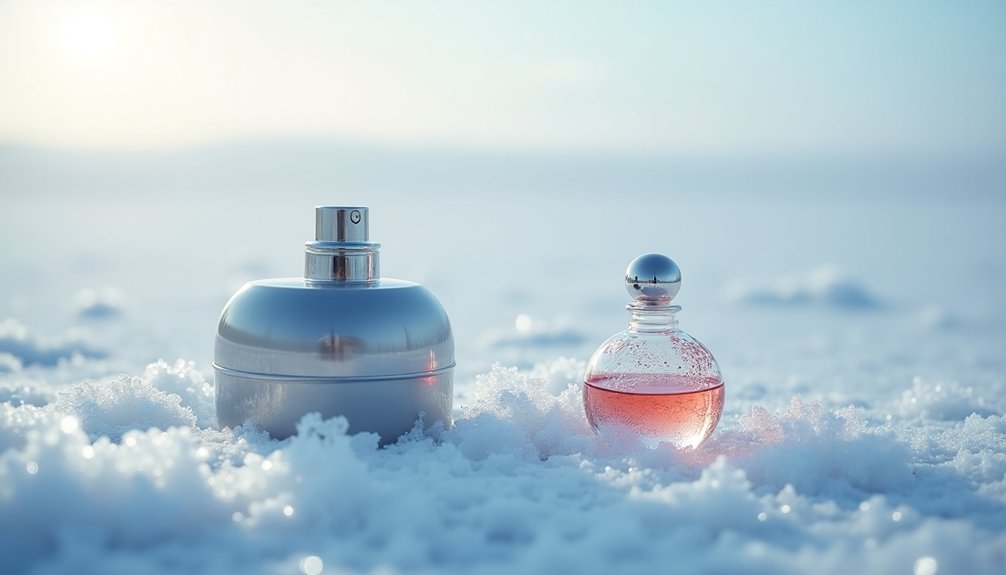
Testing fragrances in cold environments requires unique considerations that can profoundly impact your results.
When you're evaluating scents in temperatures around 10-15°C, you'll notice that volatile compounds evaporate more slowly, creating a different olfactory experience than in warmer conditions. You'll want to focus on how the fragrance develops over time, as cold temperatures can markedly alter both projection and longevity.
- Store your test samples in a refrigerator or use ice packs to maintain consistent cool temperatures that accurately simulate winter conditions.
- Monitor the fragrance's evolution at specific time intervals, as cold weather can reveal unique aspects of the scent profile.
- Test on multiple skin types, since cold temperatures affect everyone's skin chemistry differently, leading to varied fragrance performance.
Optimal Temperature Ranges for Different Fragrance Families
When evaluating fragrances, each scent family responds uniquely to specific temperature ranges, making precise environmental control essential for accurate assessment.
You'll find floral fragrances perform best between 18-22°C, where they won't become overly sweet. For citrus scents, aim for 20-25°C to maintain their zesty brightness.
If you're testing woody or oriental fragrances, slightly warmer temperatures of 22-27°C will help reveal their complex characteristics.
Fresh aquatic scents need cooler conditions around 18-22°C to preserve their crisp, clean profiles.
Remember that you'll want to avoid testing any fragrance above 27°C, as high temperatures can destabilize the scent molecules and accelerate evaporation, leading to distorted results.
Keep these temperature ranges in mind for the most accurate fragrance assessment experience.
Seasonal Temperature Adjustments in Testing
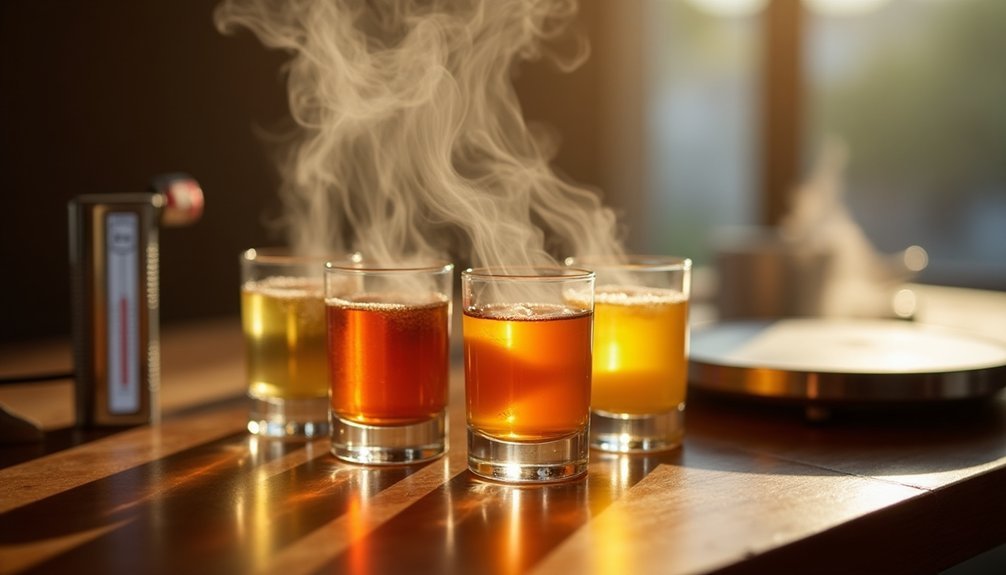
Since seasonal changes dramatically affect fragrance performance, you'll need to adjust your testing temperatures throughout the year to simulate real-world conditions.
To truly understand a fragrance, test it across different temperatures – nature's way of revealing a scent's complete character.
You'll discover that lower temperatures help you understand how scents behave in winter, while higher temps reveal their summer personalities. By documenting these variations, you're building a complete picture of your fragrance's behavior across seasons.
- Test your fragrances at cooler temperatures (below room temperature) to evaluate winter performance and longevity.
- Run warm-weather simulations at elevated temperatures to assess how your scents will project during summer months.
- Keep detailed temperature records during your tests to track how specific fragrance components react to seasonal changes.
Monitoring Temperature Changes During Evaluation
Maintaining precise control over temperature conditions proves vital for accurate fragrance evaluation, as even minor fluctuations can dramatically alter your test results.
You'll want to document all environmental conditions meticulously, focusing on temperature variations that might affect your scent's stability.
For professional testing, you can use climate chambers to create controlled environments at specific temperatures.
When you're testing at room temperature, you'll establish your baseline for longevity, while accelerated aging tests at 40°C can simulate a full year's degradation in just three months.
Don't forget to assess your fragrance's performance across seasonal temperatures – you'll need to test at both lower and higher temperatures to understand how your scent evolves throughout the year.
This systematic approach guarantees you'll capture accurate data about your fragrance's stability and performance.
Temperature-Controlled Storage Methods
Proper storage methods build upon your temperature monitoring efforts to ascertain consistent fragrance testing results.
You'll need to control multiple environmental factors to preserve your samples' integrity and guarantee accurate testing outcomes. Store baseline samples in your fridge to maintain their original characteristics, while using dark storage conditions to prevent unwanted molecular changes from light exposure.
For professional-level stability testing, you'll want to:
- Keep reference samples refrigerated to establish reliable comparison points
- Maintain test samples at 40°C for three-month periods to simulate yearly aging effects
- Utilize both light and dark storage environments to understand how different conditions impact your fragrances over time
These temperature-controlled methods will help you detect degradation early and predict long-term stability with greater accuracy.
Frequently Asked Questions
What Temperature Is Best for Fragrances?
You'll get the most accurate fragrance performance at room temperature (20-22°C). If you're testing longevity and stability, you can try cooler temps for cold-weather wear or warmer conditions around 40°C.
What Is the 30 50 20 Rule for Perfume?
The 30 50 20 rule guides your perfume's composition: you'll want 30% top notes for initial impact, 50% middle notes for the main character, and 20% base notes for lasting depth and foundation.
How to Test Fragrance Longevity?
Spray your fragrance on pulse points, write down the start time, and check hourly to track scent evolution. Don't rub wrists together. You'll get accurate longevity results by documenting when you can't smell it anymore.
Does Room Temperature Affect Fragrance?
Yes, room temperature considerably affects your fragrance's performance. You'll notice changes in scent projection and longevity as temperatures fluctuate. Keep your fragrances at consistent room temperature to maintain their intended scent profile.
In Summary
You'll get the most accurate fragrance evaluations by maintaining strict temperature control throughout your testing process. Keep your samples at 68-72°F (20-22°C) for initial testing, and don't forget to account for seasonal changes. Store your fragrances properly, monitor temperature fluctuations, and adjust your testing protocols accordingly. With these temperature-focused techniques, you're now equipped to conduct professional-level fragrance assessments like an industry expert.
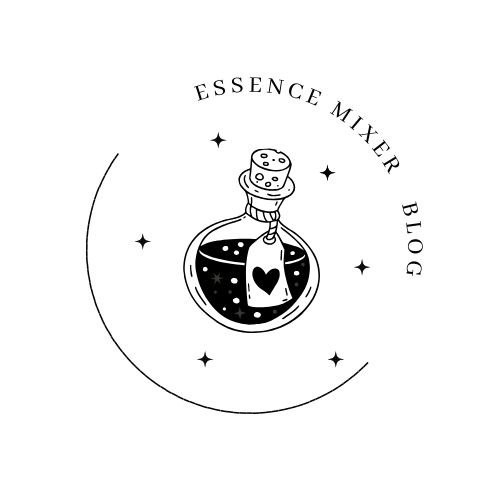
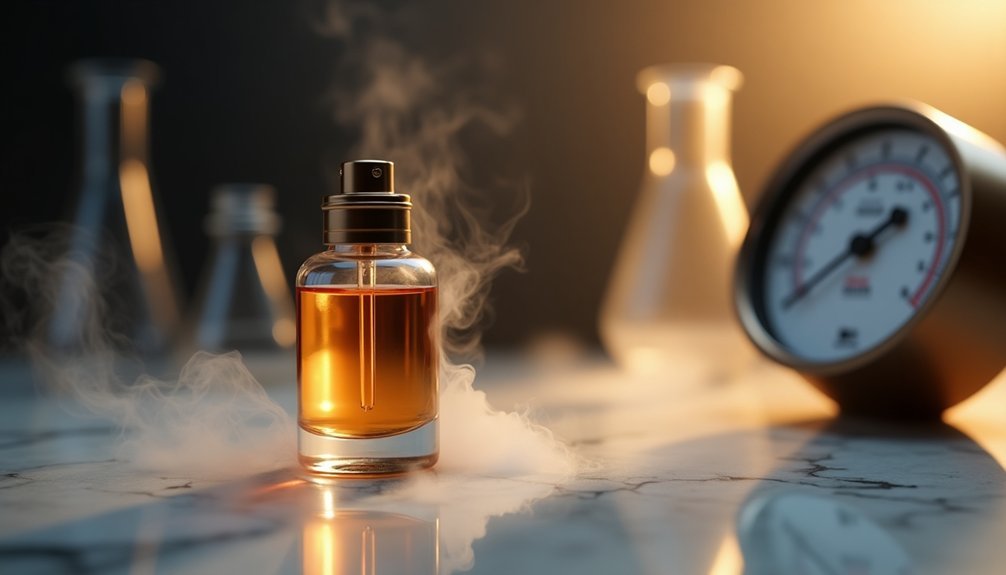



Leave a Reply